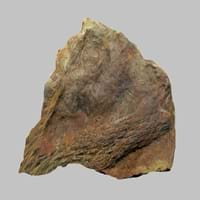Siltstone and Mylonite
Definition
Definition
Siltstone can be defined as a fine-grained sedimentary rock which mainly consists of consolidated silt
Mylonite is a metamorphic rock formed by ductile deformation during intense shearing encountered during folding and faulting, a process termed cataclastic or dynamic metamorphism
History
Origin
Unknown
New Zealand
Discoverer
Unknown
Unknown
Etymology
From English word silt and stone and from Proto-Indo-European root sal and stainaz
From Greek mulōn mill + -ite
Class
Sedimentary Rocks
Metamorphic Rocks
Sub-Class
Durable Rock, Hard Rock
Durable Rock, Medium Hardness Rock
Family
Group
Not Applicable
Not Applicable
Other Categories
Fine Grained Rock, Opaque Rock
Fine Grained Rock, Opaque Rock
Texture
Texture
Clastic
Foliated
Color
Brown, Red, Reddish Brown
Black to Grey
Maintenance
Less
Less
Durability
Durable
Durable
Water Resistant
Yes
Yes
Scratch Resistant
Yes
Yes
Stain Resistant
No
No
Wind Resistant
Yes
No
Acid Resistant
Yes
No
Appearance
Rough
Dull, Banded and Foilated
Uses
Architecture
Interior Uses
Decorative Aggregates, Interior Decoration
Decorative Aggregates, Interior Decoration
Exterior Uses
As Building Stone, As Facing Stone, Garden Decoration
As Building Stone, As Facing Stone, Paving Stone, Garden Decoration
Other Architectural Uses
Curbing
Curbing
Industry
Construction Industry
Building houses or walls, Cement Manufacture, Construction Aggregate, for Road Aggregate, Making natural cement, Raw material for the manufacture of mortar
for Road Aggregate, Landscaping, Roadstone
Medical Industry
Not Yet Used
Not Yet Used
Antiquity Uses
Artifacts, Sculpture, Small Figurines
Artifacts, Monuments
Other Uses
Commercial Uses
Raw material for the manufacture of mortar, Soil Conditioner
Creating Artwork, Gemstone, Jewelry
Types
Types
Not Available
Blastomylonites, Ultramylonites and Phyllonites
Features
Available in Lots of Colors and Patterns, Easily splits into thin plates, Generally rough to touch, High silica content, Very fine grained rock
Surfaces are often shiny
Archaeological Significance
Monuments
Not Yet Used
Used
Famous Monuments
Not Applicable
Data Not Available
Sculpture
Used
Used
Famous Sculptures
Data Not Available
Data Not Available
Pictographs
Not Used
Used
Petroglyphs
Not Used
Used
Figurines
Used
Used
Fossils
Present
Absent
Formation
Formation
Siltstone is a type of sedimentary rock which is formed from fine rock particles. As the particles of eroded rock travel along with water, the edges of the rock are worn-out by water into a rounded shape.
Mylonites are ductilely deformed rocks formed by the accumulation of large shear strain, in ductile fault zones.
Composition
Mineral Content
Calcite, Clay, Clay Minerals, Feldspar, Micas, Quartz, Sand, Silica, Silt
Porphyroblasts
Compound Content
Aluminium Oxide, CaO, Iron(III) Oxide, Potassium Oxide, MgO, Sodium Oxide, Silicon Dioxide
Aluminium Oxide, Calcium Sulfate, Chromium(III) Oxide, Iron(III) Oxide, Magnesium Carbonate, Silicon Dioxide
Transformation
Metamorphism
No
No
Types of Metamorphism
Not Applicable
Not Applicable
Weathering
Yes
Yes
Types of Weathering
Biological Weathering, Chemical Weathering, Mechanical Weathering
Biological Weathering, Chemical Weathering, Mechanical Weathering
Erosion
Yes
Yes
Types of Erosion
Chemical Erosion, Coastal Erosion, Glacier Erosion
Chemical Erosion, Sea Erosion, Wind Erosion
Properties
Physical Properties
Hardness
6-7
3-4
Grain Size
Fine Grained
Fine Grained
Fracture
Conchoidal
Conchoidal
Streak
White
White
Porosity
Highly Porous
Highly Porous
Luster
Dull
Shiny
Compressive Strength
Not Available
1.28 N/mm2
32
Cleavage
Not Available
Conchoidal
Toughness
2.6
Not Available
Specific Gravity
2.54-2.73
2.97-3.05
Transparency
Opaque
Opaque
Density
2.6-2.7 g/cm3
2.6-4.8 g/cm3
Thermal Properties
Specific Heat Capacity
Not Available
1.50 kJ/Kg K
3
Resistance
Heat Resistant, Impact Resistant, Pressure Resistant, Water Resistant
Heat Resistant, Impact Resistant, Pressure Resistant
Reserves
Deposits in Eastern Continents
Asia
China, India, Kazakhstan, Mongolia, Russia, Uzbekistan
China, India, Indonesia, Saudi Arabia, South Korea
Africa
Namibia, Nigeria, South Africa
Eritrea, Ethiopia, Ghana, South Africa, Western Africa
Europe
Austria, Denmark, Germany, Great Britain, Netherlands, Norway, Poland, Sweden, Switzerland, United Kingdom
England, Finland, France, Germany, Great Britain, Greece, United Kingdom
Others
Greenland
Not Yet Found
Deposits in Western Continents
North America
Canada, USA
USA
South America
Brazil
Not Yet Found
Deposits in Oceania Continent
Australia
New South Wales, New Zealand
Central Australia, Western Australia
All about Siltstone and Mylonite Properties
Know all about Siltstone and Mylonite properties here. All properties of rocks are important as they define the type of rock and its application. Siltstone belongs to Sedimentary Rocks while Mylonite belongs to Metamorphic Rocks.Texture of Siltstone is Clastic whereas that of Mylonite is Foliated. Siltstone appears Rough and Mylonite appears Dull, Banded and Foilated. The luster of Siltstone is dull while that of Mylonite is shiny. Siltstone is available in brown, red, reddish brown colors whereas Mylonite is available in black to grey colors. The commercial uses of Siltstone are raw material for the manufacture of mortar, soil conditioner and that of Mylonite are creating artwork, gemstone, jewelry.
|
||
|
||
|










